Summary Overview
Blister Packaging Market Overview:
The global blister packaging market is witnessing remarkable growth, driven by the rising demand for secure pharmaceutical packaging, advancements in packaging materials, and the increasing adoption of sustainable solutions. This market serves various industries, including pharmaceuticals, consumer goods, and food products. Our report provides a detailed analysis of procurement trends, emphasizing cost optimization strategies through supplier collaborations and the growing use of automated production technologies to streamline packaging operations.
Future procurement challenges include addressing fluctuating raw material costs and enhancing responsiveness to market demand through digital supply chain solutions. Strategic sourcing and efficient procurement management are critical for optimizing blister packaging processes and meeting industry standards. As competition intensifies, companies are leveraging market intelligence and analytics to strengthen supplier relationships and maintain a competitive edge.
The outlook for the blister packaging market remains robust, with substantial growth projected through 2032 due to several contributing factors:
-
Market Size: The global blister packaging market is expected to reach USD 8.72 billion by 2032, growing at a CAGR of approximately 6.14% from 2024 to 2032.
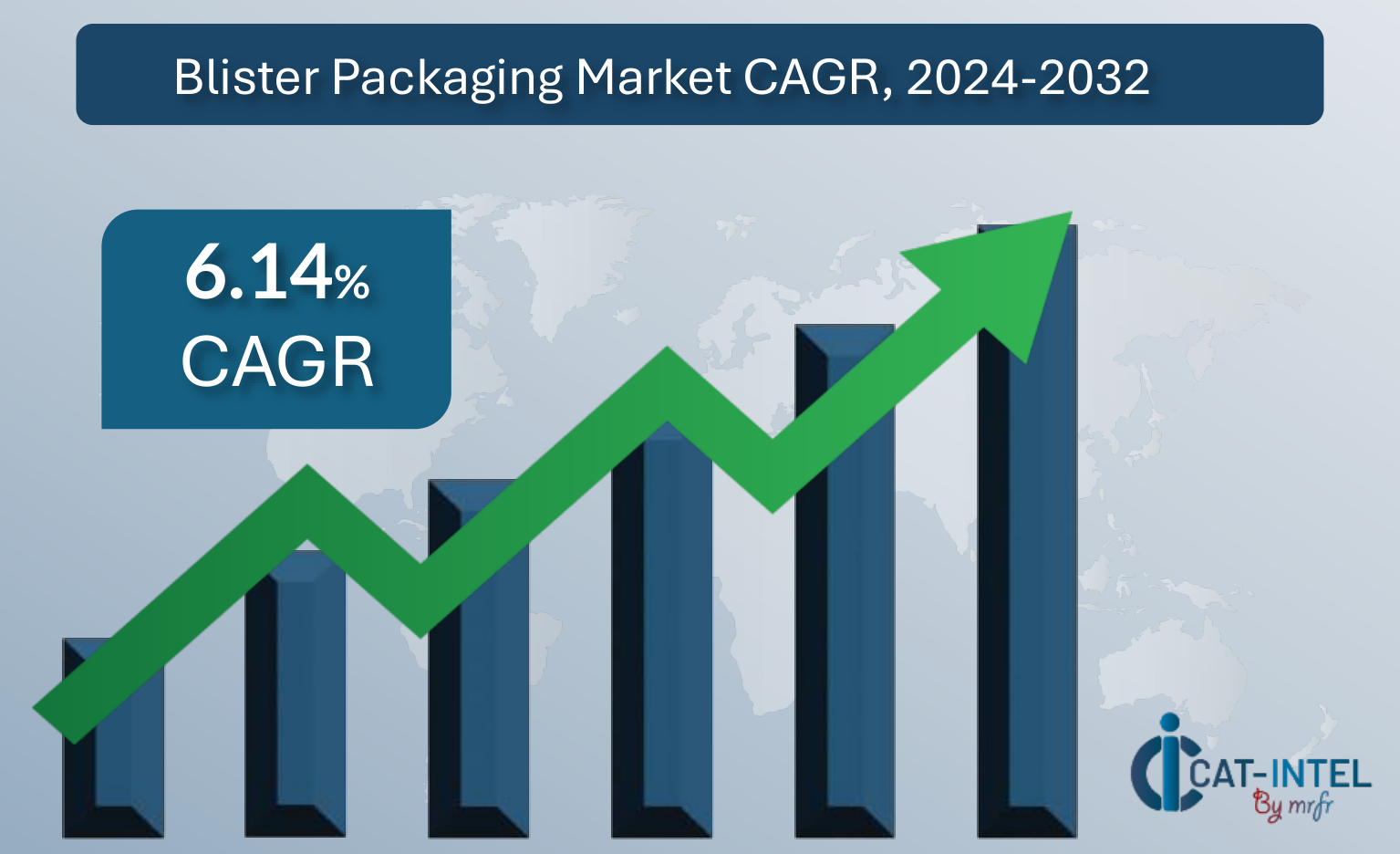
-
Sector Contributions: Key growth drivers include: -
Pharmaceutical Packaging Demand: Increased reliance on blister packaging for tamper-proof and dosage-controlled packaging. -
Sustainability Push: Rising demand for recyclable and eco-friendly packaging materials. -
Technological Transformation and Innovations: Advancements in packaging technology, including high-speed thermoforming machines and digital printing, are improving packaging quality and operational efficiency. -
Investment Initiatives: Companies are investing in automated systems and smart packaging technologies to enhance production efficiency and meet sustainability goals. -
Regional Insights: North America remains a key market due to technological advancements and strong demand from the healthcare sector, while emerging economies are witnessing growth due to expanding pharmaceutical production.
Key Trends and Sustainability Outlook:
-
Digital Integration: The adoption of automated machinery and digital printing is enhancing packaging accuracy and reducing production timelines. -
Innovative Packaging Solutions: Development of child-resistant and senior-friendly designs is gaining traction. -
Eco-Friendly Practices: Companies are focusing on minimizing material waste and adopting recyclable materials to meet sustainability objectives. -
Demand for Customization: Increasing preference for tailored packaging solutions that align with specific product and regulatory requirements. -
Data-Driven Operations: Use of analytics for demand forecasting and production optimization is becoming more prevalent.
Overview of Market Intelligence Services for the Blister Packaging Market:
Recent analyses indicate that the blister packaging market faces challenges due to fluctuating material prices and rising operational costs, driven by growing customization demands and sustainability regulations. Market reports provide cost breakdowns and identify savings opportunities, enabling companies to mitigate cost pressures while maintaining product quality. Leveraging these insights, stakeholders can implement cost-effective procurement strategies and enhance supply chain management for optimal performance.
Procurement Intelligence for Blister Packaging: Category Management and Strategic Sourcing
To sustain competitiveness in the blister packaging market, companies are refining procurement practices by using spend analysis tools to track supplier costs and adopting market intelligence for improved sourcing decisions. Effective category management and strategic sourcing are critical for achieving cost-efficient procurement and ensuring the consistent availability of high-quality packaging materials.
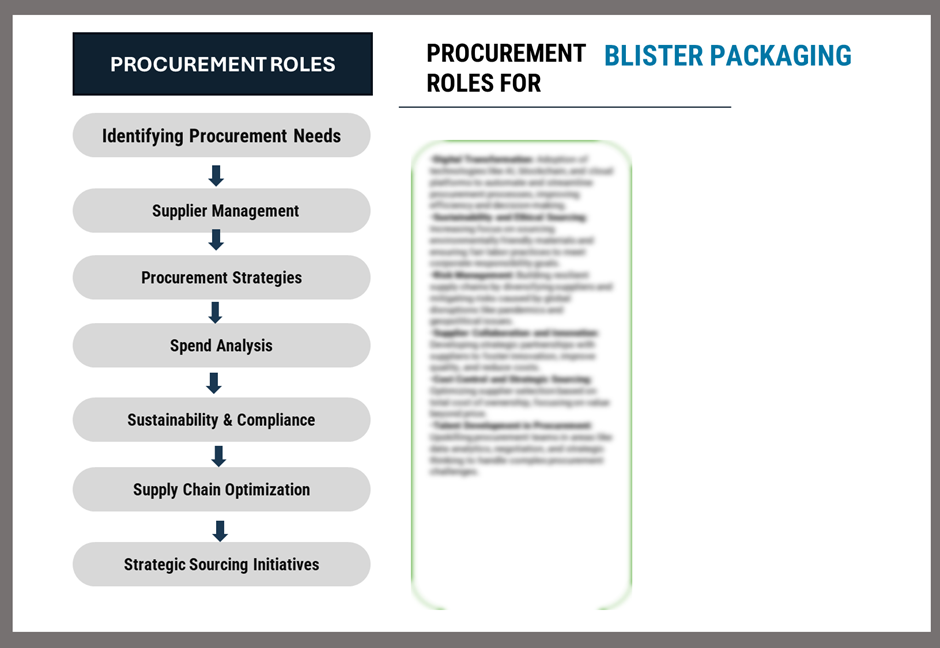
Pricing Outlook for Blister Packaging: Spend Analysis
The pricing outlook for blister packaging is expected to remain stable, with potential moderate increases due to various factors. Rising costs of raw materials, technological advancements in packaging processes, and stricter environmental regulations are key contributors to price escalations. The increasing demand for secure, tamper-proof, and sustainable packaging across industries such as pharmaceuticals and FMCG may also drive-up costs.
Graph shows general upward trend pricing for blister packaging and growing demand. However, there may be fluctuations influenced by economic conditions, technological advancements, and competitive dynamic.

Efforts to improve production efficiency, integrate automated systems, and adopt innovative designs can help manufacturers maintain competitive pricing over time. Collaborating with technology providers and material suppliers that emphasize cost-effective and sustainable solutions will further support affordability.
Despite cost pressures, ensuring quality, compliance with industry standards, and alignment with sustainability goals will remain critical. As the demand for blister packaging continues to grow, companies must focus on balancing cost control with superior service delivery to meet customer expectations.
Cost Breakdown for Blister Packaging Total Cost of Ownership (TCO) and Cost-Saving Opportunities:
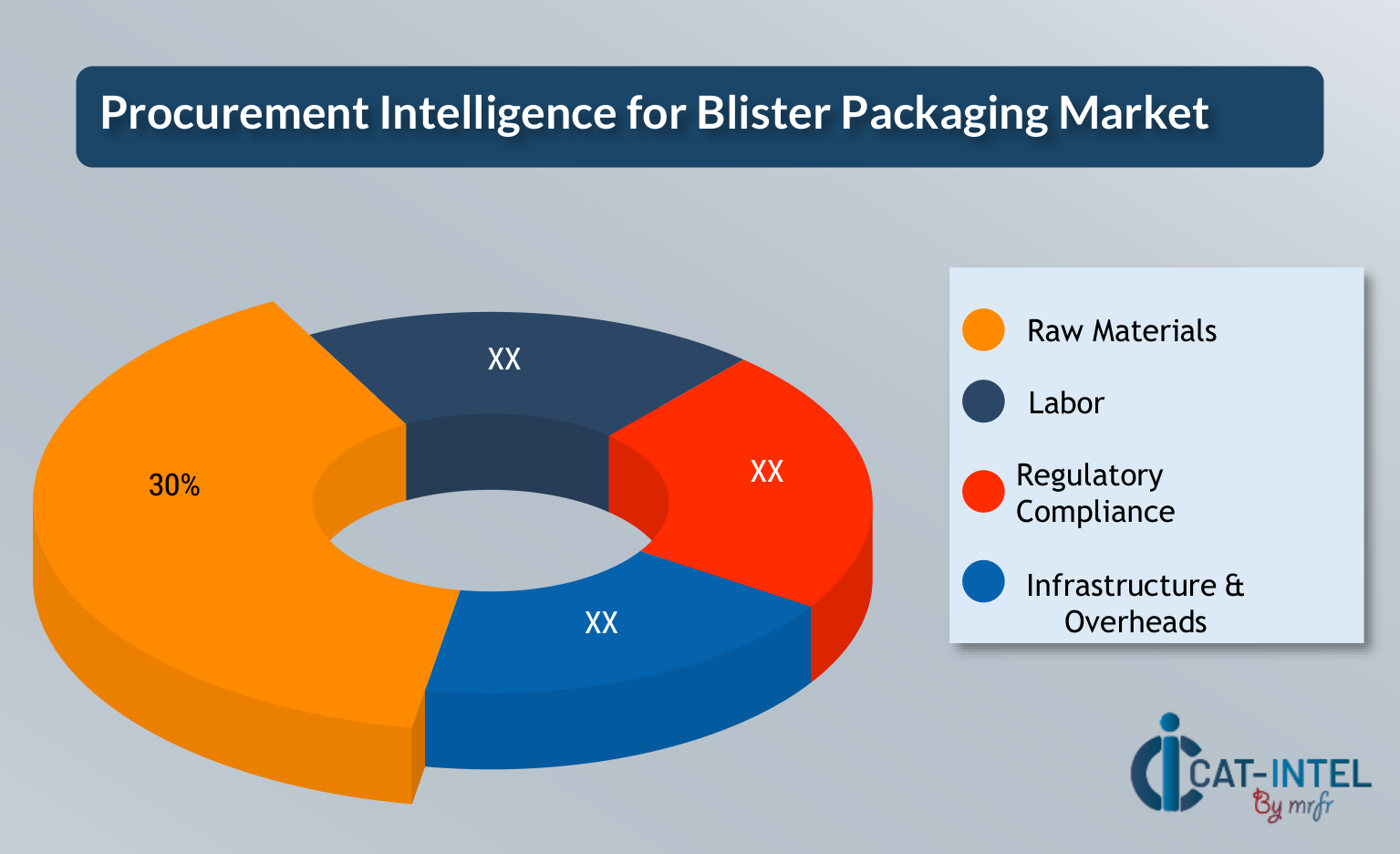
- Raw Materials (30%)
- Description: Raw materials include PVC, aluminium foils, thermoformable films, and sustainable alternatives. These materials must meet safety, durability, and compliance standards for various applications, especially in the pharmaceutical sector.
- Trends: Growing demand for recyclable and biodegradable materials is shaping the market, driven by regulatory shifts and sustainability goals. Technological improvements in material formulation are also reducing wastage and enhancing efficiency.
- Labor (XX%)
- Regulatory Compliance (XX%)
- Infrastructure & Overheads (XX%)
Cost Saving Opportunities: Negotiation Lever and Purchasing Negotiation Strategies
Cost-saving opportunities in blister packaging can be realized by refining procurement strategies and optimizing operational processes. Establishing strategic partnerships with suppliers of raw materials, packaging equipment, and logistics providers allows businesses to secure bulk purchase discounts and optimize resource allocation. These collaborations can enhance cost-efficiency and improve the organization’s negotiating power, enabling better terms and reduced per-unit expenses.
Investing in advanced manufacturing technologies, such as automated blister packing machines and digital monitoring systems, can streamline production workflows, minimize material waste, and reduce operational redundancies. Such innovations not only improve efficiency but also enhance the overall accuracy and consistency of packaging outputs, leading to long-term savings.
Incorporating sustainable practices, such as transitioning to recyclable or biodegradable materials and reducing packaging waste, further contributes to cost reductions while aligning with environmental regulations and customer preferences. These efforts not only cut costs but also bolster brand reputation by demonstrating a commitment to sustainability, a growing priority for businesses and consumers alike.
Supply and Demand Overview for Blister Packaging: Demand-Supply Dynamics and Buyer Intelligence for Effective Supplier Relationship Management (SRM)
The blister packaging market is witnessing significant growth, driven by increasing demand for safe and convenient pharmaceutical packaging, rising adoption in consumer goods, and advancements in packaging technology. Demand is particularly fuelled by the need for secure, tamper-evident solutions, supported by collaborations between manufacturers, regulatory bodies, and packaging experts.
Demand Factors:
-
Growing Pharmaceutical Industry: With the rising production of drugs and healthcare products, blister packaging is in high demand for its ability to ensure safety, dosage accuracy, and regulatory compliance. -
Increased Focus on Sustainability: The shift towards eco-friendly and recyclable materials has boosted demand for innovative blister packaging solutions that align with environmental goals. -
Rising Consumer Preferences for Convenience: Blister packaging's portability, durability, and ease of use have made it a preferred choice across various industries, especially in pharmaceuticals and fast-moving consumer goods (FMCG). -
Stringent Regulatory Standards: Growing emphasis on tamper-proof and child-resistant packaging in healthcare is driving demand for high-quality, compliant blister packaging.
Supply Factors:
-
Advancements in Packaging Technology: Innovations such as thermoforming and cold-forming techniques enhance production efficiency and quality, strengthening the supply side of blister packaging. -
Skilled Workforce Availability: The supply is influenced by the availability of trained professionals proficient in operating advanced packaging machinery and ensuring quality standards. -
Infrastructure and Production Capacity: Manufacturers with state-of-the-art facilities and robust production lines are better equipped to meet rising demand and ensure timely delivery. -
Market Competition: Increasing numbers of suppliers in the blister packaging market encourage innovation and competitive pricing but also intensify resource allocation challenges as firms aim to offer superior value.
Regional Demand-Supply Outlook: Blister Packaging:
The Image shows growing demand for blister packaging in both North America and Asia, with potential price increases and increased Competition.
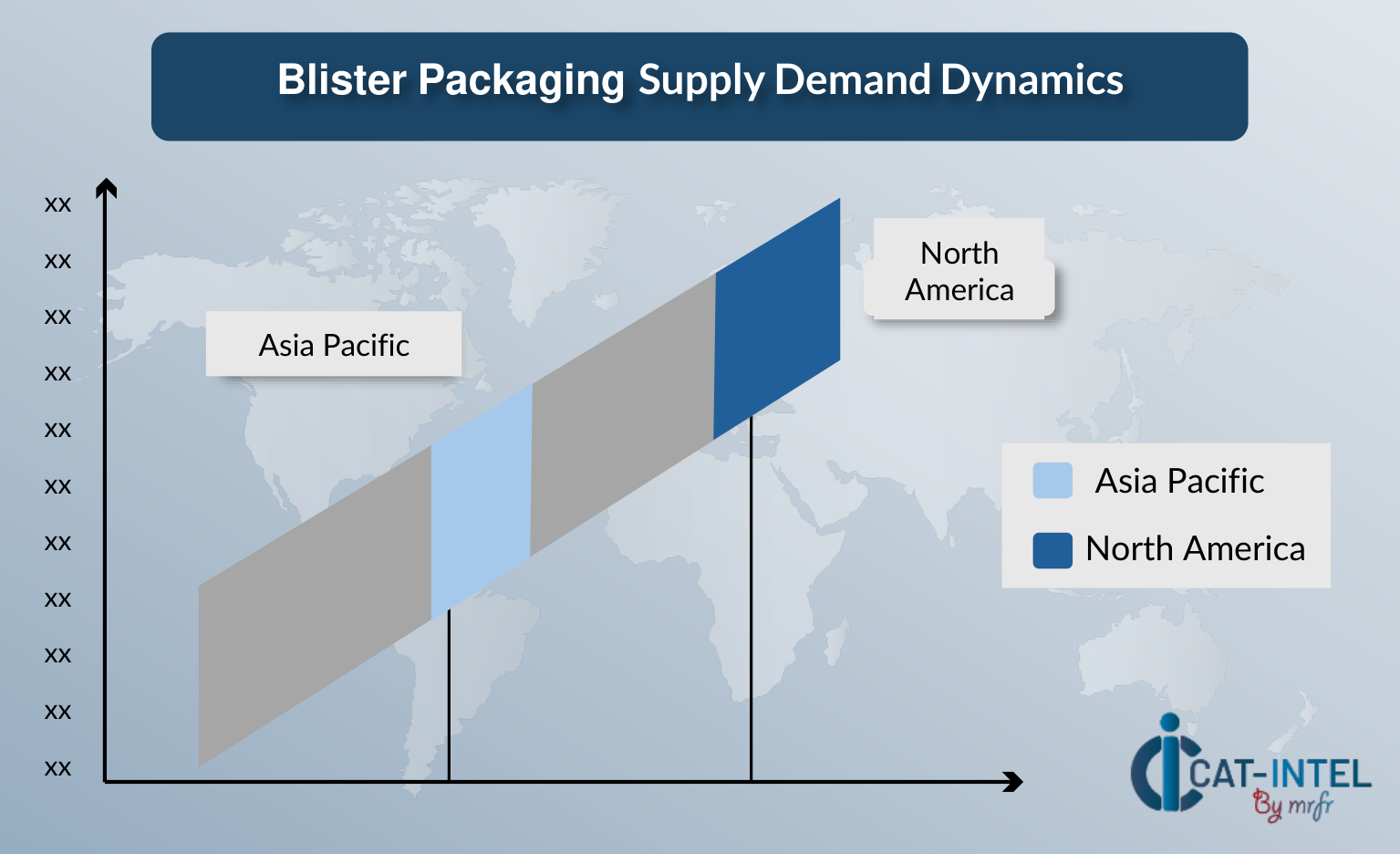
North America: Dominance in Blister Packaging
North America, particularly the U.S. and Canada, maintains a leading position in the blister packaging market, driven by key factors such as:
-
Increasing Pharmaceutical Production: With a growing demand for pharmaceuticals, including generic drugs, North American manufacturers are heavily utilizing blister packaging to meet regulatory requirements and ensure product safety, quality, and compliance. -
Advanced Manufacturing Infrastructure: The region is home to cutting-edge production facilities equipped with the latest packaging machinery, including automated blister packaging lines and advanced thermoforming technologies. -
Strict Regulatory Standards: North America enforces rigorous guidelines for pharmaceutical and medical packaging, ensuring compliance with safety and sustainability requirements. -
Technological Innovations in Packaging: The North American market is pioneering advancements in smart packaging solutions, including RFID-enabled blister packs and eco-friendly materials.
North America Remains a key hub blister packaging can price drivers Innovation and Growth.

Supplier Landscape: Supplier Negotiations and Strategies
The supplier landscape in the blister packaging market is vast, comprising a mix of global and regional players that shape the market by driving innovation, influencing pricing structures, and enhancing packaging solutions. This competitive market includes large-scale manufacturers, specialized packaging firms, and suppliers offering eco-friendly alternatives.
The blister packaging industry has seen notable consolidation among major suppliers who command significant market shares, leveraging their advanced production capabilities and global reach. However, smaller suppliers and emerging companies are gaining traction by focusing on sustainable materials, customized solutions, and innovative packaging designs that cater to niche market demands.
Key suppliers in the blister packaging market include:
- West Rock
- Amcor plc
- Bemis Company, Inc.
- WestRock Company
- Sonoco Products Company
- Constantia Flexibles Group GmbH
- Honeywell International Inc.
- Klockner Pentaplast Group
- Uflex Limited
- Tekni-Plex, Inc.
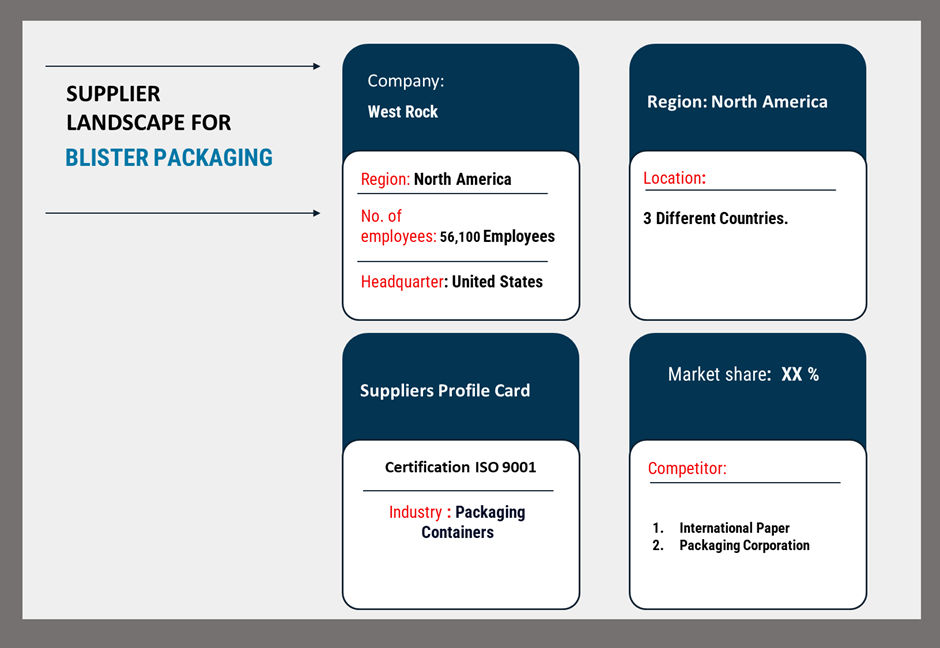
Key Developments Procurement Category Significant Development:
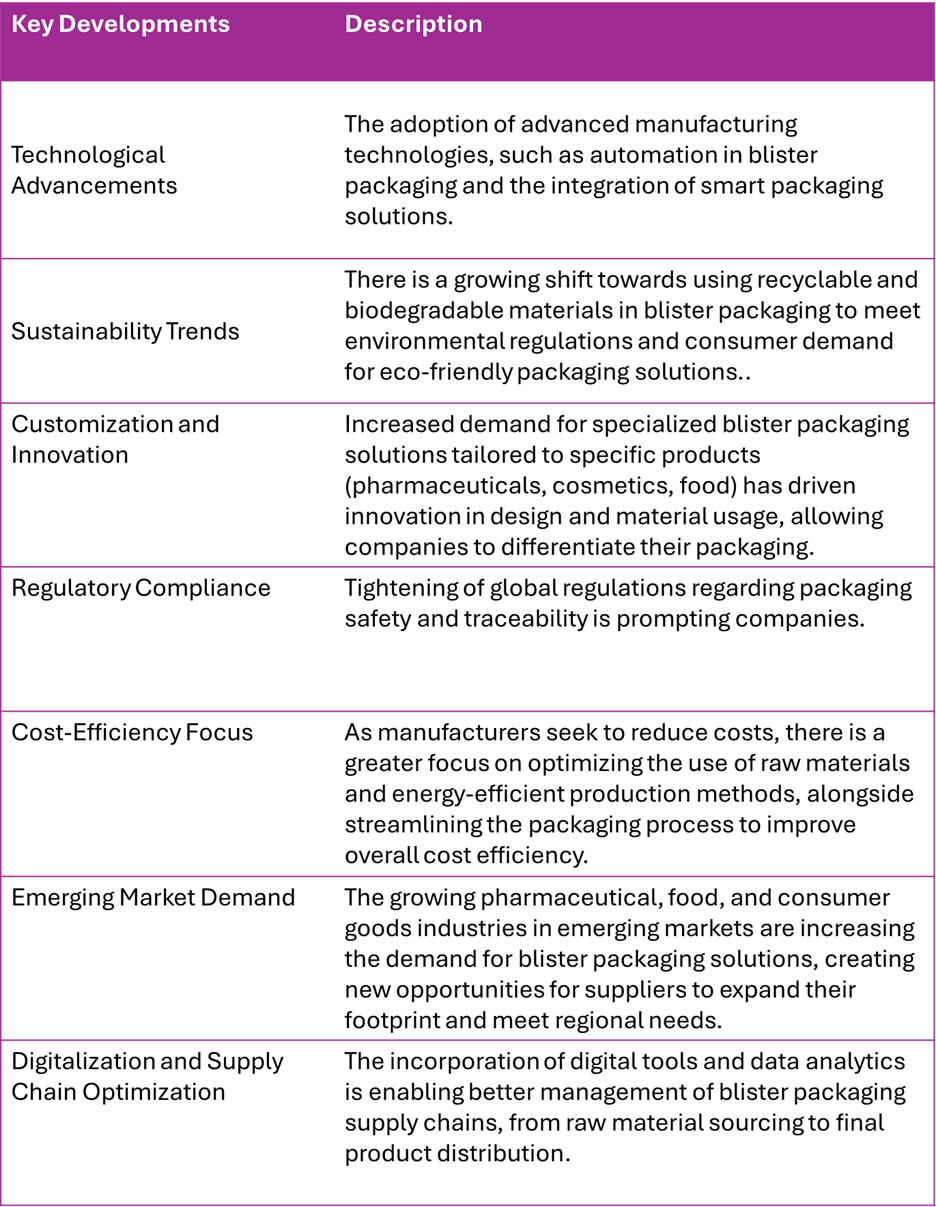
Blister Packaging Attribute/Metric |
Details |
Market Sizing |
Global blister packaging market is expected to reach USD 8.72 billion by 2032, growing at a CAGR of approximately 6.14% from 2024 to 2032. |
Blister Packaging Technology Adoption Rate |
Over 45% of packaging manufacturers are adopting advanced packaging technologies such as RFID, smart packaging, and automation for improved production efficiency and product tracking. |
Top Blister Packaging Strategies for 2024 |
Focus on sustainability, enhancing packaging customization, integrating digital technologies, and ensuring regulatory compliance for food and pharmaceutical packaging. |
Blister Packaging Process Automation |
35% of companies have implemented automation in blister packaging processes, including filling, sealing, and inspection, to improve speed and reduce errors. |
Blister Packaging Process Challenges |
Key challenges include rising material costs, maintaining compliance with packaging regulations, and meeting the increasing demand for sustainable packaging solutions. |
Key Suppliers |
Major suppliers in the market include Amcor, WestRock, Berry Global, Sealed Air, and Sonoco, offering a wide range of blister packaging materials and services. |
Key Regions Covered |
North America, Europe, and Asia-Pacific, with significant market presence in the U.S., Germany, China, and Japan due to high demand from pharmaceuticals and consumer goods industries. |
Market Drivers and Trends |
Growth driven by demand for more sustainable and customizable packaging, advancements in smart packaging technologies, and increasing regulation around packaging safety and sustainability. |

